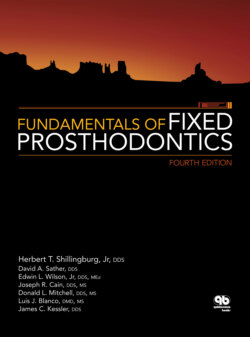Читать книгу Fundamentals of Fixed Prosthodontics - James C. Kessler - Страница 123
ОглавлениеTable 7-1 Types of prostheses used for the replacement of missing teeth
| Removable partial denture | Conventional tooth-supported fixed partial denture | Resin-bonded tooth-supported fixed partial denture | Implant-supported fixed partial denture | |
|---|---|---|---|---|
| Span length | Posterior spans longer than 2 teeth Anterior spans longer than 4 incisors Canine + 2 or more contiguous teeth | Posterior span: 2 or fewer Incisors: 4 or fewer | Single tooth Possible for 2 incisors | Single tooth 2- to 6-unit span |
| Span configuration | No distal abutment Multiple or bilateral edentulous spaces | Usually has distal abutment but can be used with short cantilever pontic | Abutments mesial and distal to pontic | No distal abutment Pier in 3+ pontic span All abutments at ends and as pier(s) of long span |
| Abutment alignment | Tipped abutments can be tolerated Widely divergent abutment alignment | Less than 25-degree inclination can be accommodated by preparation modification | Less than 15-degree inclination mesiodistally Should be in same faciolingual plane Preparations are not easily modified because of minimal reduction | Need for implant/abutment alignment requires close coordination between surgeon and restorative dentist |
| Abutment condition | Short clinical crownsInsufficient abutments | Good if abutments need crowns Nonvital teeth can be used if there is sufficient coronal tooth structure | Defect-free abutments Incisor, premolar replacements | Defect-free abutments requiring no restoration |
| Occlusion | More adaptable to irregularities in a healthy opposing natural dentition | Favorable loading (magnitude, direction, frequency, duration) | Cannot be used for incisor replacement in presence of deep vertical overlap | Occlusal forces must be as nearly vertical as possible to prevent unfavorable lateral loading of implants |
| Periodontal condition | Can use alternate (secondary) abutments when primary abutments are weakened | Good alveolar bone support Crown-root ratio 1:1 or better No mobility Favorable root morphology Provides rigid stabilization | No mobility Periodontal splints (with auxiliary resistance in tooth preparation) | Dense bone |
| Ridge form | Gross tissue loss in residual ridge | Moderate resorption No gross soft tissue defects | Moderate resorption No gross soft tissue defects | Broad, flat ridge |
| General features | Dry mouth: poor prognosis Limited patient finances Acceptable oral hygiene Reliable recall candidate Treatment simplification Advanced age Systemic health problems More adaptable to dentition in transition to edentulous state | Dry mouth: high caries risk Muscular discoordination Mandibular tori Palatal soft tissue lesions Large tongue Exaggerated gag reflex Unfavorable attitude toward RPD Patient can’t cope with aging, tooth loss Favorable opposing occlusion: removable prosthesis or periodontally weakened natural dentition may permit FPD in less than optimal situations Must be within dentist’s skills | Well suited for young patients Can be used for replacing molars if masticatory muscles are not too well developed | Able to survive in dry mouth May be better choice if teeth will require extensive treatment and will still be weak, questionable abutments Unfavorable attitude toward RPD Must be within dentist’s skills |
RPD, removable partial denture; FPD, fixed partial denture.
